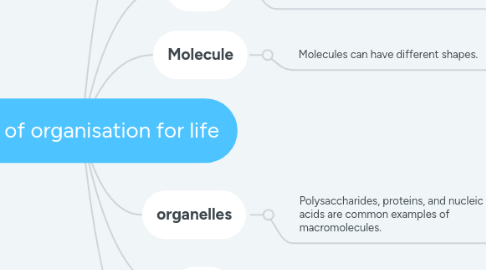
1. Atom
1.1. contain a dense nucleus surrounded by a cloud of electrons
1.1.1. The interior of the nucleus contains positively charged protons,
1.1.1.1. almost all atoms' nuclei contain neutrally charged neutrons.
2. Molecule
2.1. Molecules can have different shapes.
2.1.1. A perfect diamond is a single molecule
2.1.1.1. A perfect diamond is a single molecule
3. Macromolecule
3.1. Macromolecules are large complex molecules present in colloidal state in intercellular fluid.
3.1.1. They are formed by the condensation of low molecular weight micromolecules and hence are polymeric in nature
3.1.1.1. Polysaccharides, proteins, and nucleic acids are common examples of macromolecules.
4. organelles
4.1. Polysaccharides, proteins, and nucleic acids are common examples of macromolecules.
4.1.1. Examples of organelles are lysosomes, nucleus , mitochondria , and the endoplasmic reticulum .
4.1.1.1. ore organelles are found in virtually all eukaryotic cells
5. cells
5.1. Cells are the basic building blocks of living things.
5.1.1. The human body is composed of trillions of cells, all with their own specialised function
5.1.1.1. Cells are the basic structures of all living organisms.

